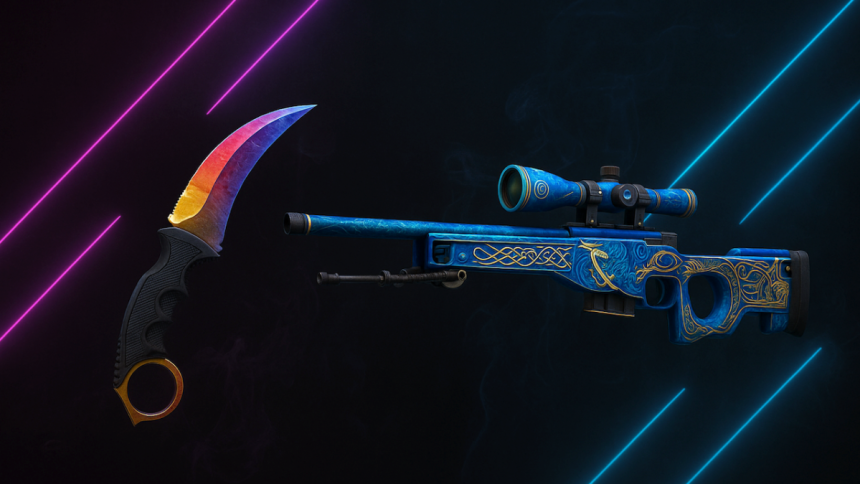In the world of Counter-Strike 2 (CS2), ‘blue-chip’ skins are virtual items that have garnered significant value and prestige due to their rarity and aesthetic appeal. Discover these exclusive skins on CSGOFast, a platform that offers exciting opportunities for gamers. These skins, such as Dragon Lore and Howl, are highly sought after because they are difficult to acquire and often tied to limited-time releases or rare gameplay drops. Their unique designs, sometimes the result of collaborations with artists or special editions, enhance their desirability among players and collectors. Additionally, the historical significance and market demand for these skins contribute to their status as symbols of pride and prestige within the gaming community.
Characteristics of Blue-Chip CS2 Skins
In the world of Counter-Strike 2 (CS2), ‘blue-chip’ skins refer to those virtual items that hold significant value and prestige. These skins are distinguished by several key characteristics that set them apart from the rest. Primarily, rarity is a defining feature. Skins such as Dragon Lore and Howl are examples of items that are not only difficult to acquire but also have limited availability, making them highly sought-after. This scarcity results from a combination of factors, including limited-time releases or rare drops during gameplay.
Another important characteristic is the aesthetic appeal of the skin. Blue-chip skins often feature unique designs or color schemes that resonate with players, enhancing their desirability. This aesthetic value is sometimes tied to collaborations with artists or special editions that further elevate their status among collectors and players alike.
Factors Contributing to Blue-Chip Status
The demand for blue-chip CS2 skins is driven by several factors. One of the most significant is the historical significance of the skin. Skins that have been part of the CS2 ecosystem for a long time and have maintained their popularity often achieve a legendary status. For instance, skins like Dragon Lore and rare knives have become iconic due to their association with notable events or players within the game community.
Furthermore, market demand plays a crucial role in establishing a skin’s blue-chip status. As more players seek to own these rare items, their value appreciates over time. The community’s perception of certain skins as status symbols also contributes to their desirability, often making them a point of pride for those who possess them.
Additional Elements
- Rarity and Limited Availability: Hard-to-find skins due to restricted drops or special events.
- Aesthetic Appeal: Unique designs that stand out visually.
- Historical Significance: Long-standing favorites that have achieved iconic status.
- Market Demand: High interest from the player base driving value upwards.
- Community Perception: Seen as prestige items within the gaming community.
In conclusion, blue-chip CS2 skins are defined by their rarity, aesthetic value, and the demand they generate within the gaming community. These factors combine to create virtual items that are not only valuable but also hold a special place in the hearts of players and collectors alike.
Origins and Early Developments
The concept of skins in Counter-Strike emerged with the release of “Counter-Strike: Global Offensive” (CS:GO) in 2012, marking an innovative step in how players could personalize their in-game experience. Initially, these virtual items were purely cosmetic, designed to alter the appearance of weapons without affecting gameplay. The introduction of skins quickly gained traction, driven largely by their aesthetic appeal and the novelty of customization in the competitive gaming scene. This initial launch laid the groundwork for a burgeoning virtual economy, where players could trade and sell skins through Steam’s marketplace.
The Growth of the Skin Market
As the popularity of CS:GO surged, so did the market for skins. The introduction of rare skins, often through randomized loot drops or cases, added an element of chance that captivated players and collectors alike. This system mirrored the excitement found in collectible card games, where the rarity and desirability of certain items drove demand. Over time, the market evolved into a dynamic and complex ecosystem, with some skins fetching thousands of dollars. The trading community became a vibrant part of the game’s culture, with dedicated forums and discussions focusing on strategies to acquire highly sought-after items.
Iconic Skins and Their Impact
Several skins have achieved iconic status due to their rarity and design, significantly influencing the market. The “Dragon Lore” AWP, for example, is one such legendary skin. Known for its intricate design and limited availability, it has become synonymous with prestige and exclusivity. Similarly, the “Howl” M4A4 skin gained notoriety due to its unique backstory—it was initially removed from circulation due to a copyright dispute, which only heightened its value and allure. Rare knife skins also play a pivotal role; items like the Karambit and Butterfly Knife, especially in coveted finishes, are regarded as status symbols within the community.
Market Maturation and Blue-Chip Skins
Over the years, the CS:GO skin market has matured, leading to the designation of certain skins as blue-chip items. These skins consistently appreciate in value, much like traditional investments, and are often seen as stable assets within the virtual economy. The enduring popularity of skins like the Dragon Lore, Howl, and rare knives underscores their role in shaping market perceptions and trends. As players continue to engage with these virtual items, the market for CS2 skins is expected to evolve, reflecting broader shifts in player preferences and technological advancements in gaming.
Market Trends and Investment Potential
In the dynamic world of CS2 skins, market trends significantly influence the blue-chip status of certain items. The skins market, akin to traditional financial markets, experiences fluctuations driven by both predictable patterns and unexpected events. Blue-chip skins like Dragon Lore and Howl have demonstrated consistent appreciation over time, a trend that makes them attractive to investors. This appreciation is often fueled by the skins’ historical performance and the prestige associated with owning such sought-after items.
Investment potential in CS2 skins is also bolstered by the speculative nature of the market. Investors look at past trends and the potential for future growth to guide their decisions. For instance, the limited availability of certain skins or their association with significant gaming events can spike demand and drive up prices. This perception of potential future value encourages investors to hold onto blue-chip skins, further solidifying their status as valuable assets.
Supply and Demand Dynamics
Supply and demand dynamics play a critical role in the blue-chip status of CS2 skins. The scarcity of certain skins directly impacts their market value. When supply is limited, and demand is high, prices naturally climb, enhancing the perceived value of these items among collectors and investors. This scarcity is often a result of limited production runs, discontinued availability, or the skins being part of exclusive collections.
Demand for blue-chip CS2 skins is also influenced by their desirability, which can be attributed to their visual appeal, rarity, and the prestige they confer within the gaming community. Collectors often seek out these skins as status symbols, further driving demand. The interplay between limited supply and strong demand creates a competitive market environment where the most coveted skins command premium prices.
Key Factors Affecting Demand:
– Historical significance and in-game achievements.
– The aesthetic appeal and uniqueness of the design.
– Endorsement or usage by popular players or influencers.
– Limited edition releases or event-related exclusives.
– Cultural trends within the gaming community.
These economic factors collectively shape the market for blue-chip CS2 skins, influencing both their short-term desirability and long-term investment potential. By understanding these dynamics, investors and collectors can make informed decisions that align with their financial goals and personal interests.
Community Perception and Player Endorsements
The blue-chip status of certain CS2 skins is significantly influenced by community perception and player endorsements. Within the gaming community, perceptions are often shaped by a combination of rarity, aesthetic appeal, and historical significance. Players and influencers who carry considerable weight within the community frequently highlight specific skins, which can dramatically enhance their desirability. When a well-regarded player consistently uses a particular skin, it gains visibility and prestige, which in turn influences the broader community’s view of its value.
Moreover, community events and tournaments often serve as platforms where these skins gain further recognition. When top-tier players use specific skins in high-stakes matches, the skins are not just tools of the trade but become symbols of skill and status, increasing their appeal and value. This kind of endorsement from players acts as a catalyst, driving demand and elevating certain skins to blue-chip status.
Media Representation and Cultural Significance
Media representation plays a pivotal role in shaping the cultural significance of CS2 skins. Coverage by gaming media outlets and content creators amplifies the visibility of particular skins, showcasing them in gameplay videos, reviews, and articles. This media exposure not only educates potential buyers about the skins but also highlights their cultural significance within the gaming community. For example, iconic skins like Dragon Lore or Howl often feature in discussions about gaming history and aesthetics, further embedding them in the cultural fabric of the game.
The cultural impact is also reflected in the way these skins are perceived beyond the game. Skins that achieve blue-chip status often transcend their in-game functionality to become cultural artifacts within the gaming world. This transformation is supported by fan art, merchandise, and cosplay, which further solidify their status. The combination of media portrayal and community-driven content ensures that these skins maintain a prominent place in the gaming culture, reinforcing their value and appeal.
Factors Contributing to Blue-Chip Status
Several key factors contribute to the blue-chip status of certain CS2 skins, driven by community and cultural influences:
- Influencer Endorsements: Skins used by popular players become aspirational items.
- Media Coverage: Features in articles and videos elevate skins to iconic status.
- Cultural Integration: Skins that become part of gaming lore and culture increase in value.
- Event Exposure: Skins highlighted in tournaments gain prestige and desirability.
- Community Engagement: Active discussions and fan creations support a skin’s reputation.
These elements work together to ensure that certain CS2 skins not only retain their value but also become integral to the cultural and community identity within the gaming ecosystem.
Conclusion
Blue-chip CS2 skins are characterized by their rarity, aesthetic value, and strong market demand within the gaming community. They often boast unique designs and historical significance, contributing to their status as sought-after collectibles. The market dynamics of supply and demand further enhance their value, with limited availability playing a critical role. Community perceptions, player endorsements, and media representation also significantly impact the desirability of these skins, embedding them into gaming culture. As a result, blue-chip skins maintain their allure as prestigious items among players and collectors, reflecting broader trends in the virtual economy.
Lynn Martelli is an editor at Readability. She received her MFA in Creative Writing from Antioch University and has worked as an editor for over 10 years. Lynn has edited a wide variety of books, including fiction, non-fiction, memoirs, and more. In her free time, Lynn enjoys reading, writing, and spending time with her family and friends.















